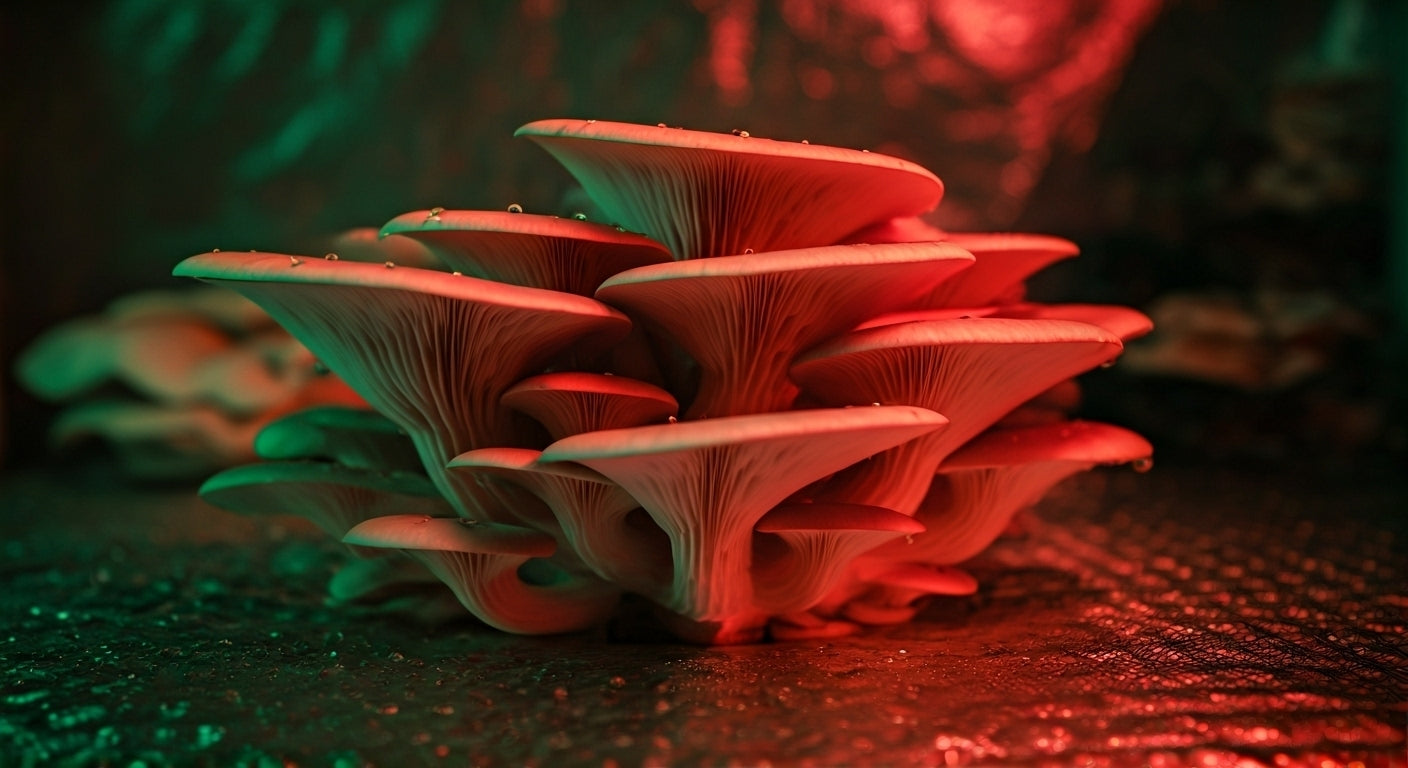
How Much Humidity for Mushroom Grow Tent: Complete Guide 2025
Determining how much humidity for mushroom grow tent cultivation requires understanding the specific environmental needs that enable successful fruiting and prevent contamination. Unlike traditional plant growing that typically requires 40-60% humidity, mushroom cultivation demands significantly higher moisture levels ranging from 70-95% depending on the growth stage and species. Proper humidity management represents one of the most critical factors separating successful mushroom growers from those who struggle with poor yields, contamination issues, and failed crops.
The relationship between humidity and mushroom development extends beyond simple moisture provision - it affects cellular development, triggers fruiting mechanisms, and influences the formation of healthy, marketable mushrooms. Modern grow tent technology enables precise humidity control that transforms mushroom cultivation from an unpredictable endeavor into a systematic science yielding consistent, high-quality harvests.
Understanding Humidity Requirements by Growth Stage
Incubation Phase Humidity Needs
During the initial incubation phase when mycelium colonizes the substrate, mushroom grow tents require moderate humidity levels of 70-80% to support healthy development without encouraging contamination. This controlled environment prevents substrate desiccation while avoiding excessive moisture that promotes bacterial growth or competitive mold development.
The Gorilla Mushroom Grow Tent provides excellent environmental control during this critical phase, featuring durable construction and precision ventilation systems that maintain stable conditions throughout the 10-21 day colonization period typical for most gourmet mushroom species.
Fruiting Stage Requirements
Once substrate colonization completes and fruiting initiation begins, humidity requirements increase dramatically to 80-95% to support proper primordial development and prevent mushroom desiccation. This high humidity environment triggers the formation of pin heads while ensuring adequate moisture for rapid mushroom development.
Different mushroom species exhibit varying sensitivity to humidity fluctuations during fruiting. Oyster mushrooms tolerate minor variations better than delicate species like shiitake, which require extremely stable conditions to prevent cap cracking or stunted development.
Species-Specific Humidity Requirements
Oyster Mushrooms (Pleurotus Species)
Oyster mushrooms represent one of the most forgiving species for beginning growers, thriving in humidity ranges of 85-95% during fruiting. These robust fungi tolerate some humidity fluctuation while still producing excellent yields. During the critical first 7-8 hours after pinning initiation, maintain humidity above 90% to ensure proper cluster formation.
Temperature coordination with humidity becomes crucial for oyster mushrooms, as they prefer cooler conditions (55-75°F) that help maintain higher relative humidity levels naturally. The combination of proper humidity and temperature creates optimal growing conditions that produce the dense, meaty clusters oyster mushrooms are known for.
Shiitake Mushrooms
Shiitake cultivation requires more precise humidity management, with optimal levels of 80-90% during fruiting. These premium mushrooms exhibit greater sensitivity to environmental fluctuations and benefit from gradual humidity adjustments rather than sudden changes that can cause cap cracking or poor formation.
The longer development cycle of shiitake mushrooms (often 3-4 weeks from substrate inoculation to harvest) demands consistent humidity maintenance throughout extended growing periods. Quality grow tent systems with reliable automation prove essential for maintaining the stable conditions shiitake requires.
Specialty Mushrooms (Lion's Mane, Reishi, Maitake)
Premium specialty mushrooms often require species-specific humidity protocols that differ from common varieties. Lion's mane benefits from 85-95% humidity with excellent air circulation to promote the characteristic cascading growth pattern. Reishi mushrooms prefer slightly lower humidity (80-90%) with extended growing periods that test humidity control system reliability.
The Gorilla Mushroom Grow Tent systems accommodate these diverse requirements through adjustable environmental controls and reliable construction that maintains precise conditions throughout extended growing cycles.
Humidity Control Methods and Equipment
Humidification Systems
Ultrasonic humidifiers provide the most precise humidity control for mushroom grow tents, producing fine mist that distributes evenly throughout the growing space. These systems offer programmable controls, automatic shutoff features, and sufficient output capacity to maintain high humidity levels in sealed environments.
Quality humidification systems include built-in hygrometers, timer controls, and adjustable output settings that enable precise environmental management. Investment in reliable humidity equipment pays dividends through improved yields, reduced contamination, and simplified daily management routines.
Humidity Controllers and Automation
Automated humidity controllers eliminate the guesswork and constant monitoring required for successful mushroom cultivation. These devices monitor real-time humidity levels and activate humidification equipment as needed to maintain target ranges automatically.
Advanced controllers offer features like data logging, remote monitoring, and integration with other environmental systems that create comprehensive growing automation. Such sophisticated controls enable consistent results while reducing labor requirements and minimizing human error.
Passive Humidity Methods
Simple humidity management techniques like water trays, wet towels, and substrate misting provide basic moisture control for smaller operations or backup systems. While less precise than automated systems, these methods offer reliable humidity supplementation when properly implemented.
Strategic placement of water features within grow tents creates humidity gradients that can benefit different growth stages simultaneously. Understanding airflow patterns and evaporation rates enables optimization of passive humidity systems for specific growing objectives.
Environmental Balance and Air Exchange
Balancing Humidity with Fresh Air
Maintaining high humidity while providing adequate fresh air exchange represents one of the most challenging aspects of mushroom cultivation. Excessive ventilation reduces humidity below optimal levels, while insufficient air exchange allows CO2 buildup that inhibits fruiting and encourages contamination.
Modern grow tent systems incorporate sophisticated ventilation controls that cycle fresh air while preserving humidity levels. Timer-controlled fans, humidity-activated ventilation, and positive pressure systems enable the delicate balance between moisture retention and air quality management.
Preventing Condensation Problems
Excessive humidity can create condensation issues that promote bacterial growth and contamination. Proper tent design, insulation, and air circulation prevent condensation accumulation while maintaining optimal growing humidity levels.
Strategic equipment placement, temperature management, and ventilation design eliminate condensation-prone areas within grow tents. Understanding dew point relationships and thermal dynamics enables system optimization that maximizes humidity benefits while minimizing associated risks.
Monitoring and Measurement
Digital Monitoring Systems
Accurate humidity measurement requires quality digital hygrometers positioned strategically throughout grow tent environments. Multiple sensors provide comprehensive coverage that reveals humidity gradients and enables targeted adjustments for optimal growing conditions.
Advanced monitoring systems offer data logging, alarm capabilities, and wireless connectivity that enable remote oversight of growing conditions. Historical data analysis reveals patterns and trends that guide system optimization and troubleshooting efforts.
Calibration and Maintenance
Regular calibration of humidity monitoring equipment ensures accurate readings that form the basis for environmental control decisions. Quality instruments maintain accuracy over time when properly maintained and periodically calibrated against reference standards.
Preventive maintenance schedules for humidification equipment, sensors, and control systems prevent equipment failures that could destroy entire crops. Understanding equipment limitations and replacement schedules protects investments in mushroom cultivation operations.
Troubleshooting Common Humidity Issues
Low Humidity Problems
Insufficient humidity manifests as dried, cracked mushroom caps, stunted growth, and poor cluster development. Addressing low humidity requires systematic evaluation of humidification capacity, air leaks, and environmental conditions that may be reducing moisture levels.
Solutions include upgrading humidification equipment, sealing tent leaks, reducing air exchange rates, and adding passive humidity sources. Understanding the root causes of humidity loss enables targeted solutions that restore optimal growing conditions.
Excessive Humidity Complications
While mushrooms require high humidity, excessive moisture creates ideal conditions for bacterial contamination, mold growth, and mushroom quality problems. Managing overly humid conditions requires careful adjustment of ventilation, temperature, and humidification systems.
Gradual humidity reduction prevents shocking developing mushrooms while eliminating conditions that support harmful microorganisms. Balancing humidity reduction with maintaining adequate moisture for healthy growth requires experience and careful monitoring.
Seasonal and Environmental Considerations
Climate Impact on Humidity Control
Regional climate conditions significantly affect humidity management within grow tents. Arid climates require more aggressive humidification, while humid regions may need dehumidification during certain seasons to maintain optimal growing conditions.
Seasonal variations in ambient humidity, temperature, and air pressure influence grow tent environmental control requirements. Successful operations adapt their humidity management strategies to account for these external factors that affect internal growing conditions.
Location-Specific Adjustments
Indoor growing locations within homes or buildings create unique environmental challenges that affect humidity control. Basements typically offer naturally higher humidity but may require temperature management, while upper floors may need more aggressive humidification.
Understanding microclimate conditions within different growing locations enables optimization of humidity control systems for specific installations. The Gorilla Mushroom Grow Tent systems adapt to various environmental conditions through robust construction and flexible configuration options.
Advanced Humidity Management Techniques
Vapor Pressure Deficit Optimization
Understanding vapor pressure deficit (VPD) relationships enables sophisticated humidity management that optimizes mushroom transpiration and development. VPD calculations consider both humidity and temperature to determine the driving force for moisture movement within mushroom tissues.
Advanced growers utilize VPD management to fine-tune growing conditions for specific species and development stages. This sophisticated approach to environmental control maximizes growth rates while minimizing stress factors that could reduce yield or quality.
Microclimate Creation
Strategic humidity management can create beneficial microclimates within larger grow tents that accommodate different species or growth stages simultaneously. Zonal humidity control enables diverse cultivation projects within single growing environments.
Understanding air movement patterns, evaporation rates, and humidity gradients enables creation of customized growing zones that optimize conditions for specific cultivation objectives while maximizing space utilization efficiency.
Economic Considerations and Efficiency
Cost-Benefit Analysis of Humidity Systems
Investment in quality humidity control equipment typically pays for itself through improved yields, reduced crop losses, and simplified management. Calculating total cost of ownership includes equipment costs, energy consumption, and maintenance requirements.
Premium humidity control systems often provide superior long-term value through reliability, accuracy, and automation features that reduce labor costs while improving results. Consider operational efficiency and crop quality improvements when evaluating humidity equipment investments.
Energy Efficiency Optimization
Modern humidity control systems offer improved energy efficiency through variable output controls, smart sensors, and optimized operational algorithms. Energy-efficient humidity management reduces operational costs while maintaining optimal growing conditions.
Understanding power consumption patterns and optimizing equipment operation schedules can significantly reduce energy costs associated with humidity control. Smart controllers and efficient equipment selection contribute to sustainable mushroom cultivation operations.
Conclusion and Best Practices
Mastering humidity control in mushroom grow tents requires understanding species-specific requirements, implementing appropriate equipment, and maintaining consistent environmental conditions throughout growing cycles. The Gorilla Mushroom Grow Tent systems provide the foundation for successful humidity management through quality construction, reliable environmental controls, and flexible configuration options.

Success in mushroom cultivation comes from consistent attention to environmental details, systematic monitoring of growing conditions, and gradual refinement of techniques based on experience and results. Start with proven humidity ranges for chosen species, invest in quality monitoring and control equipment, and develop systematic approaches to environmental management that ensure consistent results.
Remember that humidity control represents just one component of successful mushroom cultivation, but it remains among the most critical for achieving professional-quality results. Proper humidity management enables mushrooms to reach their full genetic potential while preventing the contamination and quality issues that plague inadequately controlled growing environments.

Lena Myles
I'm a mushroom enthusiast and home cook based in Oregon. I'm passionate about foraging and creating fungi-focused recipes, especially delicious, plant-based dishes using gourmet mushrooms like trumpet, shiitake, and oyster. When I’m not in the kitchen, you’ll usually find me wandering the woods in search of new wild flavors.



